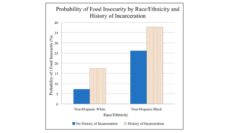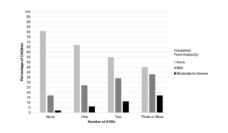With limited dietary options and the need to address a host of health challenges, prison food needs a new recipe for success.
The U.S. government spends about $45,800 on average for each incarcerated person per year. About 32% of funds are spent on health care, 42% on security, and just over 2% on food. Dietary guidelines issued by the Food and Nutritional Board of the Institute of Medicine create menus that find a way to sustain this measly percentage with around 2,200 calories of food per day, at an institutional cost of about $4 per person.
To stretch every dollar, meals are small, unappealing, and nutritionally empty. Prison food service companies pack meals with refined carbohydrates (like white bread), and provide poor quality or spoiled products that occasionally have mold or other disturbing conditions. Food safety regulation is also lax. Those incarcerated are six times more likely to experience a food-borne illness than those outside of jail and prison.
Commissaries or “canteens” are a vital alternative to what is served in the cafeteria. These retail stores within prisons are where incarcerated people can buy other sources of food (alongside hygiene products) at inflated prices. Typically, prisoners spend money on commissary provisions from the wages they earn through work. Those who are unable to pay on their own depend on their family for monetary support to make purchases possible. And while many families aid in subsidizing the prison system, the poorest people in prison spend little to no money at the commissary due to insufficient funds.
Although they are in high demand, commissaries do not offer anything fresh. Most items for sale are pre-packaged, processed foods that are filled with sugar (like candy bars) or salt (like chips or ramen noodles). When these foods become the only supplement to the already nutrient-poor meals served in the cafeteria, health worsens.
Food sustains us, but it also connects us; it is a measure of our humanity.
A diet full of carbohydrates and lacking essential vitamins and minerals can increase the risk of diabetes, hypertension, and heart disease commonly seen among incarcerated individuals. Malnutrition may contribute to a weaker immune system and an easier spread of respiratory illness, especially in these dense populations. Doctors normally recommend dietary modifications to prevent these health problems, but this option rarely exists for those in prison.
Poor food intake is also a significant factor for mental health challenges in prison populations. A study from Northern Arizona University examined the nutritional content of a rural county jail’s weekly menu and found deficits in vitamin D, magnesium, and omega-3s for its population–all nutrients that are important to good mental health. Another study found male prisoners with lower levels of omega-3s were prone to more aggression, suggesting that violence and antisocial behaviors can be reduced when nutrition is improved.
More nutritious offerings will improve the health of incarcerated populations, 90% of which will be released after their sentence is served. Small dietary changes can enhance the health of incarcerated individuals who await their three daily meals. Beyond the Chow Hall, greater access to more healthy foods in commissaries would easily enrich diets. And reduced premium prices would be useful to families—often lower-income and people of color—paying for their incarcerated family members.
More broadly, initiating prison initiatives that promote healthy eating, gardening, culinary programming and practice, and wellbeing and solidarity through food can help residents refocus efforts on rehabilitation instead of punishment.
There is a constitutional right to adequate food among incarcerated people. While the lines for what “adequate” means have been blurred, nutritious offerings should be the minimum standard. Food sustains us, but it also connects us; it is a measure of our humanity.
Photo via Getty Images














